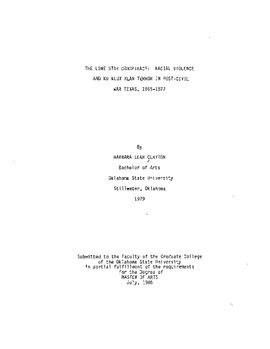| dc.description.abstract | Texas experienced relative peace within its boundaries during the Civil War. Once the war ended, with General Robert E. Lee's surrender to General Ulysses S. Grant at Appomattox Court House, for the Lone Star State the real war began. Racial tensions, experienced during the great conflict between the Blue and the Grey, emerged with renewed vigor. Vehemently, the same angry forces which had preyed on their enemies, either real or imaginary, struck again. Prior to 1865 whites targeted European and Mexican immigrants and Unionists for violence. Those same whites had kept black slaves in check despite emancipation. After 1865 Anglos transferred their hatred and aggression to all who were not ex-Confederates, white Southern Democrats, or "true" Texans. Presidential Reconstruction established a provisional government (June 19, 1865) and military occupation (August 20, 1866) for the Lone Star State. Federal officials forced Anglos in Texas to accept full and immediate freedom for blacks instead of gradual and limited emancipation, which most white Southerners favored. Denied states rights, Texans fought back by means of covert action. With the birth of the Ku Klux Klan, the hooded disguise of the secret organization gave many white Texans sanction to intimidate, terrorize, and even murder. iii By doing so they hoped to regain control of their state at least politically. Socially and economically, the Klan managed to keep the freedpeople subservient and to maintain them as a source of cheap, often free, labor. With the introduction of the Bureau of Refugees, Freedmen, and Abandoned Lands, ex-rebels called on the Klan to threaten and assassinate Union troops and bureau agents. Radical Republicans and Congressional Reconstruction added one more target for Klan destruction. By 1868, Texas, from the Red River on its northern boundary to the Gulf of Mexico and the Rio Grande on the south, experienced Klan and Klan-like terror. Klansmen and their co-conspirators murdered thousands of blacks, Mexicans, European immigrants, loyalists, and federal troops and agents. Despite army efforts to rid Texas of crime, the military proved ineffective as a policing agent. State delegates and legislators were too strongly divided among themselves to enact any positive measures to deal with the lawlessness or the plight of the freedpeople. The violence continued long after the final draft and acceptance of a state constitution and the readmission of Texas to the Union in 1870. Known Klan membership in 1872 still numbered 15,000 to 20,000. Even after the Republican governor, E. J. Davis, had been replaced by the Democrat, Richard Coke, in 1874, Klaverns still continued their nightly ghostly raids. The killing continued throughout 1875 and 1876. With the compromise of 1877, human rights and civil liberties for Texas minorities, especially for blacks, would be only a vision for which to hope and dream for years to come. | |
